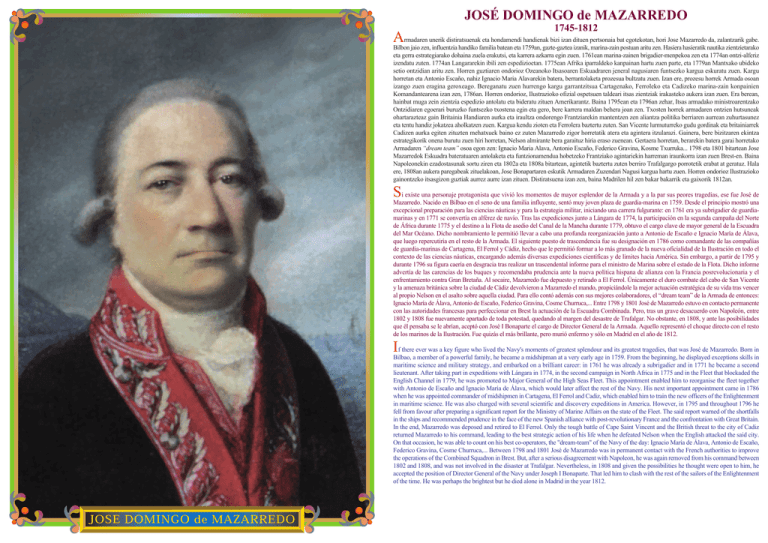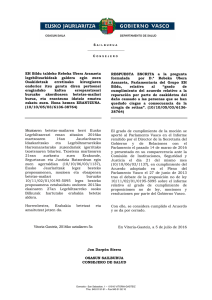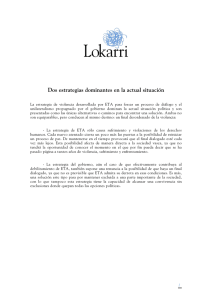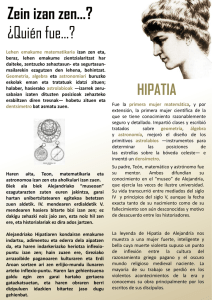Vista Previa - Foro Marítimo Vasco
Anuncio

JOSÉ DOMINGO de MAZARREDO 1745-1812 A rmadaren unerik distiratsuenak eta hondamendi handienak bizi izan dituen pertsonaia bat egotekotan, hori Jose Mazarredo da, zalantzarik gabe. Bilbon jaio zen, influentzia handiko familia batean eta 1759an, gazte-gaztea izanik, marina-zain postuan aritu zen. Hasiera hasieratik nautika zientzietarako eta gerra estrategiarako dohaina zuela erakutsi, eta karrera azkarra egin zuen. 1761ean marina-zainen brigadier-menpekoa zen eta 1774an ontzi-alferiz izendatu zuten. 1774an Langararekin ibili zen espedizioetan. 1775ean Afrika iparraldeko kanpainan hartu zuen parte, eta 1779an Mantxako ubideko setio ontzidian aritu zen. Horren guztiaren ondorioz Ozeanoko Itsasoaren Eskuadraren jeneral nagusiaren funtsezko kargua eskuratu zuen. Kargu horretan eta Antonio Escaño, nahiz Ignacio Maria Alavarekin batera, berrantolaketa prozesua bultzatu zuen. Izan ere, prozesu horrek Armada osoan izango zuen eragina geroxeago. Bereganatu zuen hurrengo kargu garrantzitsua Cartagenako, Ferroleko eta Cadizeko marina-zain konpainien Komandantearena izan zen, 1786an. Horren ondorioz, Ilustrazioko ofizial ospetsuen taldeari itsas zientziak irakasteko aukera izan zuen. Era berean, hainbat muga zein zientzia espedizio antolatu eta bideratu zituen Amerikarantz. Baina 1795ean eta 1796an zehar, Itsas armadako ministroarentzako Ontzidiaren egoerari buruzko funtsezko txostena egin eta gero, bere karrera maldan behera joan zen. Txosten horrek armadaren ontzien hutsuneak ohartarazteaz gain Britainia Handiaren aurka eta iraultza ondorengo Frantziarekin mantentzen zen aliantza politika berriaren aurrean zuhurtasunez eta tentu handiz jokatzea aholkatzen zuen. Kargua kendu zioten eta Ferrolera baztertu zuten. San Vicente lurmuturreko gudu gordinak eta britainiarrek Cadizen aurka egiten zituzten mehatxuek baino ez zuten Mazarredo zigor horretatik atera eta agintera itzularazi. Gainera, bere bizitzaren ekintza estrategikorik onena burutu zuen hiri horretan, Nelson almirante bera garaituz hiria eraso zuenean. Gertaera horretan, berarekin batera garai horretako Armadaren “dream team” osoa egon zen: Ignacio Maria Alava, Antonio Escaño, Federico Gravina, Kosme Txurruka... 1798 eta 1801 bitartean Jose Mazarredok Eskuadra bateratuaren antolaketa eta funtzionamendua hobetzeko Frantziako agintariekin harreman iraunkorra izan zuen Brest-en. Baina Napoleonekin ezadostasunak sortu ziren eta 1802a eta 1808a bitartean, agintetik baztertu zuten berriro Trafalgargo porrotetik erabat at geratuz. Hala ere, 1808an aukera paregabeak zituelakoan, Jose Bonapartaren eskutik Armadaren Zuzendari Nagusi kargua hartu zuen. Horren ondorioz Ilustrazioko gainontzeko itsasgizon guztiak aurrez aurre izan zituen. Distiratsuena izan zen, baina Madrilen hil zen bakar bakarrik eta gaixorik 1812an. S i existe una personaje protagonista que vivió los momentos de mayor esplendor de la Armada y a la par sus peores tragedias, ese fue José de Mazarredo. Nacido en Bilbao en el seno de una familia influyente, sentó muy joven plaza de guardia-marina en 1759. Desde el principio mostró una excepcional preparación para las ciencias náuticas y para la estrategia militar, iniciando una carrera fulgurante: en 1761 era ya subrigadier de guardiamarinas y en 1771 se convertía en alférez de navío. Tras las expediciones junto a Lángara de 1774, la participación en la segunda campaña del Norte de África durante 1775 y el destino a la Flota de asedio del Canal de la Mancha durante 1779, obtuvo el cargo clave de mayor general de la Escuadra del Mar Océano. Dicho nombramiento le permitió llevar a cabo una profunda reorganización junto a Antonio de Escaño e Ignacio María de Álava, que luego repercutiría en el resto de la Armada. El siguiente puesto de trascendencia fue su designación en 1786 como comandante de las compañías de guardia-marinas de Cartagena, El Ferrol y Cádiz, hecho que le permitió formar a lo más granado de la nueva oficialidad de la Ilustración en todo el contexto de las ciencias náuticas, encargando además diversas expediciones científicas y de límites hacia América. Sin embargo, a partir de 1795 y durante 1796 su figura caería en desgracia tras realizar un trascendental informe para el ministro de Marina sobre el estado de la Flota. Dicho informe advertía de las carencias de los buques y recomendaba prudencia ante la nueva política hispana de alianza con la Francia posrevolucionaria y el enfrentamiento contra Gran Bretaña. Al socaire, Mazarredo fue depuesto y retirado a El Ferrol. Únicamente el duro combate del cabo de San Vicente y la amenaza británica sobre la ciudad de Cádiz devolvieron a Mazarredo el mando, propiciándole la mejor actuación estratégica de su vida tras vencer al propio Nelson en el asalto sobre aquella ciudad. Para ello contó además con sus mejores colaboradores, el “dream team” de la Armada de entonces: Ignacio María de Álava, Antonio de Escaño, Federico Gravina, Cosme Churruca,... Entre 1798 y 1801 José de Mazarredo estuvo en contacto permanente con las autoridades francesas para perfeccionar en Brest la actuación de la Escuadra Combinada. Pero, tras un grave desacuerdo con Napoleón, entre 1802 y 1808 fue nuevamente apartado de toda potestad, quedando al margen del desastre de Trafalgar. No obstante, en 1808, y ante las posibilidades que él pensaba se le abrían, aceptó con José I Bonaparte el cargo de Director General de la Armada. Aquello representó el choque directo con el resto de los marinos de la Ilustración. Fue quizás el más brillante, pero murió enfermo y sólo en Madrid en el año de 1812. IBilbao, f there ever was a key figure who lived the Navy's moments of greatest splendour and its greatest tragedies, that was José de Mazarredo. Born in a member of a powerful family, he became a midshipman at a very early age in 1759. From the beginning, he displayed exceptions skills in maritime science and military strategy, and embarked on a brilliant career: in 1761 he was already a subrigadier and in 1771 he became a second lieutenant. After taking part in expeditions with Lángara in 1774, in the second campaign in North Africa in 1775 and in the Fleet that blockaded the English Channel in 1779, he was promoted to Major General of the High Seas Fleet. This appointment enabled him to reorganise the fleet together with Antonio de Escaño and Ignacio María de Álava, which would later affect the rest of the Navy. His next important appointment came in 1786 when he was appointed commander of midshipmen in Cartagena, El Ferrol and Cadiz, which enabled him to train the new officers of the Enlightenment in maritime science. He was also charged with several scientific and discovery expeditions in America. However, in 1795 and throughout 1796 he fell from favour after preparing a significant report for the Ministry of Marine Affairs on the state of the Fleet. The said report warned of the shortfalls in the ships and recommended prudence in the face of the new Spanish alliance with post-revolutionary France and the confrontation with Great Britain. In the end, Mazarredo was deposed and retired to El Ferrol. Only the tough battle of Cape Saint Vincent and the British threat to the city of Cadiz returned Mazarredo to his command, leading to the best strategic action of his life when he defeated Nelson when the English attacked the said city. On that occasion, he was able to count on his best co-operators, the "dream-team" of the Navy of the day: Ignacio María de Álava, Antonio de Escaño, Federico Gravina, Cosme Churruca,... Between 1798 and 1801 José de Mazarredo was in permanent contact with the French authorities to improve the operations of the Combined Squadron in Brest. But, after a serious disagreement with Napoleon, he was again removed from his command between 1802 and 1808, and was not involved in the disaster at Trafalgar. Nevertheless, in 1808 and given the possibilities he thought were open to him, he accepted the position of Director General of the Navy under Joseph I Bonaparte. That led him to clash with the rest of the sailors of the Enlightenment of the time. He was perhaps the brightest but he died alone in Madrid in the year 1812.




